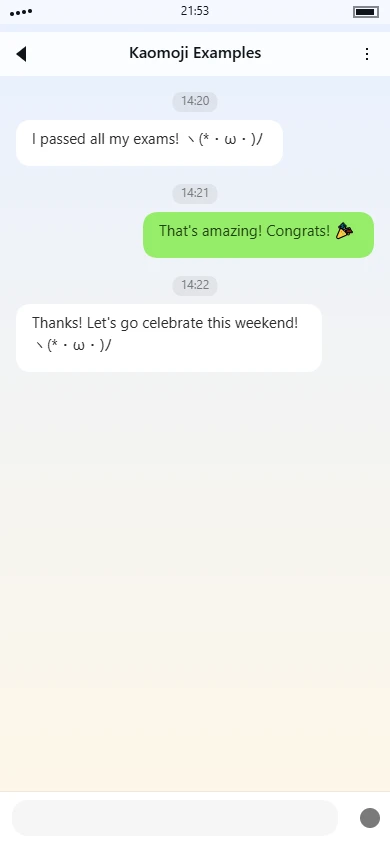(๑>◡<๑) kaomoji meaning | usage tips

Overview
This kaomoji (๑>◡<๑) presents a stylized facial expression that conveys a sense of cheerful shyness or happy embarrassment. The arrangement of characters creates a rounded face shape with distinctive eye and mouth elements that work together to express a specific emotional tone.
Visual Structure Explanation
The kaomoji uses parentheses as the outer boundary, creating a rounded facial contour that encloses the internal features. Within this frame, the eyes are represented by the Thai numeral characters "๑" on both sides, which resemble closed or squinting eyes with a slight upward curve. The central mouth element "◡" is a geometric symbol that forms a gentle upward arc, suggesting a small, content smile. The positioning of the eyes slightly outside the mouth area creates a balanced composition where the facial features appear to be gently compressed within the circular boundary, giving the impression of a slightly chubby or rounded face.
Symbol Breakdown
- Outer parentheses ( ): These serve as the facial outline, creating a circular container that defines the boundaries of the expression
- Thai numeral ๑: Used as eye symbols on both sides, these characters have a curved shape that suggests closed or happily squinted eyes
- Geometric symbol ◡: Positioned centrally as the mouth, this upward-curving arc represents a subtle, content smile
- Angle brackets > <: These symbols flank the mouth area and help separate the eye and mouth regions while adding structural definition
- Spatial arrangement: The tight grouping of symbols within the parentheses creates a compact, cohesive facial expression
Emotion & Aesthetic Analysis
This kaomoji primarily expresses a blend of happiness with a touch of shyness or modest pleasure. The closed eyes suggest contentment rather than exuberant joy, while the small upward-curving mouth indicates gentle satisfaction. The overall effect is more subdued than kaomojis with wide-open eyes or large grinning mouths, making it suitable for situations where one feels pleased but not overly excited.
Compared to similar kaomojis like (^_^) or (´∀`), this version has a more stylized and slightly more formal appearance due to the use of Thai numerals and geometric symbols. The emotional tone sits between neutral happiness and delighted excitement, making it versatile for various positive but not overwhelming emotional contexts. The compact arrangement gives it a slightly cute or endearing quality that works well in digital communication where subtle emotional nuance is desired.
Tag categories
Use tags to quickly understand this kaomoji.
Usage guide
Usage Guide for (๑>◡<๑)
The kaomoji (๑>◡<๑) is a charming and versatile expression that captures a sense of playful happiness, gentle mischief, and innocent delight in online communication. Characterized by its closed eyes with small upward curves and a wide, cheerful smile, this emoticon conveys a warm, friendly vibe that's perfect for casual conversations across messaging apps, social media platforms, and gaming communities. It typically expresses lighthearted joy, affectionate teasing, or contented satisfaction without being overly exuberant—making it ideal for situations where you want to show you're pleased but in a more subtle, cute way than with louder expressions like (≧▽≦). You'll often see it used among friends, in fan communities, or in contexts where a touch of kawaii aesthetic enhances the conversation.
Common Use Cases
- Reacting to good news from a friend in a private chat
- Expressing quiet satisfaction after completing a task or achieving a small goal
- Playfully teasing someone about a harmless inside joke
- Responding to cute pet photos or baby pictures shared in group chats
- Showing appreciation for a thoughtful compliment without sounding boastful
- Adding warmth to casual thank-you messages in informal settings
- Conveying gentle amusement at a funny but not hilarious meme
- Expressing happy anticipation for an upcoming casual event or hangout
- Softening a light confession or admission of something slightly embarrassing
- Reacting to sweet romantic gestures in dating app conversations
- Showing you're touched by a sentimental story shared by a friend
- Adding cute emphasis to expressions of agreement or support
Example Conversations
-
Friend sharing good news
"I finally passed my driving test!" "Yay! So proud of you (๑>◡<๑)"
-
Casual planning between friends
"The new café downtown has amazing matcha latte" "We should go this weekend! (๑>◡<๑)"
-
Reacting to shared content
"Check out this adorable kitten video I found" "Oh my goodness, too cute! (๑>◡<๑)"
-
Light teasing among close friends
"I may have bought three more plants today..." "Your apartment is becoming a jungle (๑>◡<๑)"
-
Expressing quiet happiness
"Just finished that book you recommended - loved it!" "So glad you enjoyed it (๑>◡<๑)"
-
Casual romantic exchange
"Thinking of you during my lunch break" "That's sweet (๑>◡<๑) me too!"
Important Notes
- Avoid using this kaomoji in professional emails, formal business communications, or serious discussions where its playful tone might seem inappropriate or unprofessional
- While generally positive, the closed eyes can sometimes be misinterpreted as smugness or self-satisfaction by those unfamiliar with kaomoji conventions, so consider your audience
- This expression works best in one-on-one conversations or small group chats rather than large public forums where its subtlety might be lost
- The tone is generally warmer and more intimate than more neutral smileys like :) so it's better suited for conversations with people you know reasonably well
- On platforms like Discord, Slack, or gaming communities, this kaomoji fits perfectly in casual channels but might seem out of place in serious topic discussions
- While universally understandable in anime and gaming circles, some Western social media users might not immediately grasp the specific nuance, so use context to ensure your meaning is clear
Cultural Note: This particular style of kaomoji with the closed eyes and wide smile originates from Japanese internet culture and is particularly popular among anime fans and in gaming communities. It carries a distinctly "kawaii" (cute) aesthetic that might read as slightly more feminine or youthful to some audiences, though it's widely used across genders in casual online spaces throughout East Asia and among global fans of Japanese pop culture.
Usage examples
Real conversation samples that feature this kaomoji.

Example 1

Example 2
Related kaomoji
You might also enjoy these kaomoji.